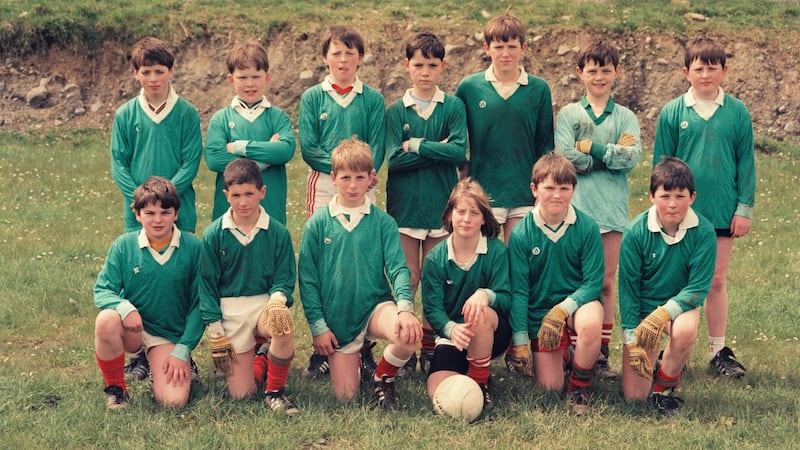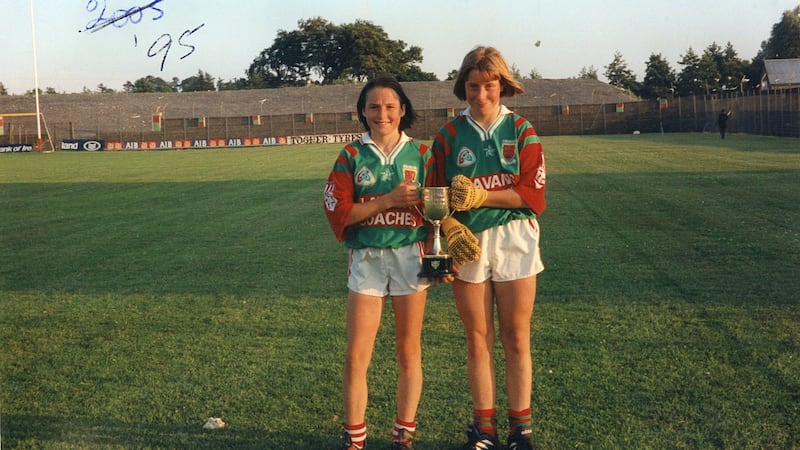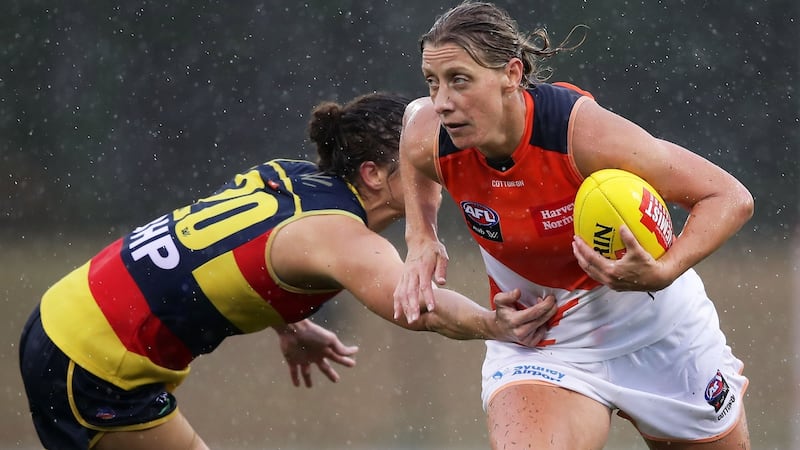“Where does it leave me? Well. I don’t see myself putting on a Mayo jersey again,” Cora Staunton says evenly on the lasting outcome of the blazing feud which has left a chasm in Mayo football.
It is disconcerting and unquestionably sad that a 24-year inter-county career of phosphorescent brilliance could simply go out as unceremoniously as a light bulb in an airing cupboard. But there it is.
It’s been a rotten few months, as she tells it. Anyone who happened to catch the news even once over the past while couldn’t have been unaware that the Mayo women’s football team – a pioneering force for the sport – has been physically and spiritually gutted in a blaze of ill-feeling, accusation and counter-accusation.
Ten of the panel and two managers gone from the panel after walking out in mid-July. A statement released explaining an atmosphere of training that they found intolerable and tantamount to “an unsafe environment”.
There followed a strenuous objection and counter argument from the team manager, Peter Leahy. The estrangement deepening into a row which deeply split public opinion and left a mess in its wake – strained friendships, a weakened team and no clean resolution.
I was born stubborn
Because the walk-out revolved around players from the Carnacon club and because Staunton is that club’s figurehead, the easy assumption is that she orchestrated the collective departure. She knows how she can come across on the football field, stroppy at times, domineering; a force of nature. On the day we meet, she has just heard that, in the latest episode in the row, Carnacon had won their appeal and would play at the weekend.
She was happy that she has a ball game to look forward to. But there is no joy in any of this. It was difficult to think about anything else and for a few weeks, when things were at their worst, she found herself dreading even walking down the town. Now, with cosmically mischievous timing, Game Changer, her biography, is in book shops this weekend.
The book, written with Mary White, is a strong self-examination of a football life that began with the utterly carefree pursuit by a child who loved chasing a ball and, like other girls, had to cope with the complications of discovering she was better than almost all the boys at the boys’ game.
And it stretches through three decades to this autumn, when a 36-year-old woman finds herself stirring a single lump of brown sugar into a coffee cup in a busy Castlebar restaurant, reasoning aloud how it came to this – an exile from a senior squad that had been like a second family and embarking on the turbulent excitement of a semi-professional career in Australian Rules.
Public realm
“I was born stubborn,” she writes on page three. It’s a short sentence that contains multitudes. Her automatic reaction to the idea of committing her story to a book was an emphatic ‘no’. But she knew, from visiting classrooms down the years, that her story registered with children. And she hoped it might give a different perspective on who she is when she is not of a football pitch.
“Maybe this gives an idea of the hours of dedication, maybe the mammying of young players that I do and the reasons I do that – it was done for me when I was younger. Maybe it will give the broader side,” she says hopefully, “and not just the Cora on the pitch who can be a bit cranky when things aren’t going well.”
One of the inadvertent aspects with excelling at anything in life is that it places the owner of that talent in the public realm. Not everyone wants that. Staunton’s precociousness at Gaelic football thrust her into the spotlight when she was still a teenager.
She was both an outstanding footballer and a radical presence in that her style of play helped to smash the old prejudice that this was a ‘man’s game’. The teenager in her just wanted to fit in. The athlete ensured she stood out and became the symbol of an emerging sport. It’s a role in which she has never felt entirely natural and she grimaces now, reliving how awkward she felt at moments when her profile as an athlete transported her to alien scenarios.

The memories still have the power to cause a blush: the gala dinner at which she was a guest of Bertie Ahern and learning on arrival that she would be seated at his table: “I didn’t even know I what I was doing there”; the evening she saw Maurice Fitzgerald and braced herself to approach him to ask for a photo only to find herself utterly tongue-tied even as she forced herself to cross the room – “the words were stuck in my mouth”.
Or the time, on an All-Star trip in San Francisco, when she wanted to tell Eamon Ryan, the Cork manager, how much she admired what he had done with his team.
“I had to have a few drinks in me before I could walk over to him. But he was the exact same as me – the shy type of person who wouldn’t go around approaching people.”
Black is black. That's the way I am. Some people like that. Some don't
Staunton frequently scolds herself for being a poor communicator. In fact, the opposite is true, she speaks in the long and articulate bursts of a seasoned debater. She is, however, a contrary mix of reserve and bluntness and, she admits, helpless in her insistence in calling thing as she sees them.
“Black is black. That’s the way I am. Some people like that. Some don’t. There is not much I can do about it now.”
Game Changer is essentially a story of sporting excellence set against a family bereavement. Mary Staunton (nee Summerville) died from cancer when Cora was just 16. "Twenty years ago in July gone by," Cora says quickly. She was a warm, practical, vital matriarch in a busy household of eight children and they were each lost without her.
Hard worker
“Mam was a really hard worker and we do live our lives by the values that she and Dad entrenched in us. Nobody was special – myself and my younger brother were because of our age, okay, but we were all the same. She’d be proud of what I’ve achieved, obviously. But she’d be proud of all of us.
“She would keep the paper cuttings and talk to the neighbours but she didn’t have time to go to all the matches. She would keep you grounded. Once you are happy with what you are doing . . . Mom would be more interested that in life you conduct yourselves the right way; you work hard at what you are doing. There wasn’t huge pressure put on us but this thing that you work your way through life.”
Sitting down with Mary White forced her to revisit and dwell on the feeling of those early months for the first time since then. There was a moment when she wavered and felt she hadn’t the heart for or interest in football anymore.

“I hadn’t really thought about any of the stuff. I was drained. It felt like being at counselling . . . And yeah, without football the route I would have gone down was out smoking and drinking and doing the stuff a 16-year-old can do . . . I probably dabbled a little bit in it but football kept me busy. I was going through the motions and then I took a break and fell out of love with it for those few months.”
It’s easy to see that divergent point on the page: heading into Fifth Year, the country quickening into wealth and ambition in 1999, 16-years-old and hyper-conscious of the fact that everyone knew her Mam had died.
I found that the football pitch was the place I could express my emotions
One person, the vice-principal in Ballinrobe, Sister Brenda, she recalls in the book, was “the only one I really remember who got it. She was strict as anything, but maybe she was more at peace in dealing with death than the rest of us. It was difficult because I always felt like people were looking at me differently. I could sense the pity off them, and it hovered over me for months on end. I kept to myself”.
It took the intervention of a few key figures in her life to entice her back to football. Her father, Michael, did everything he could to fill the void in the house after that summer. Her best friend, Yvonne ‘Crazy’ Byrne. Jimmy Casey and Beatrice Casey, her first club coaches, seemed to serve as mortal guardian angels as her football career took off. And her first coach, Finbar Egan was, she declares, “the best coach I ever had”. He had some intuition for what she needed to hear; of her aversion to pity and sympathy.
“I didn’t really want to go back to Mayo and Finbar was on to me and, from there, I found that the football pitch was the place I could express my emotions. If I was having a shit day at school and a shit day thinking about Mom, then at least the football pitch was a place I could go and burn it off. You were going home and she wasn’t there and it was sad. But you’d forget it for those few hours. I feel like the whole team took me under their wing.
Set standards
“Denise Horan in particular. I’d be telling stories about Mom and they’d make sure I talked. So I think when Finbar came along we were at a very impressionable age. I was 17 and probably at the hardest point of my life. It was a couple of months after Mam died. And you think you are coping.
“Finbar was the one person, along with Jimmy and Beatrice, who made me see football in a different way – the intricacies of the game and how to read a game. He probably set standards that were way ahead of his team. And while he was very young, he fathered us a lot without mollycoddling us. He knew when you were straying down the wrong path and he would take you off it.”
When Egan stepped down in 2004, Mayo had won four senior All-Irelands and two National League titles. They haven’t won an All-Ireland since and the labyrinthine saga of incoming and exiting managers has characterised the following seasons.
Staunton accepts that it was probably unfortunate that a figure as influential as Egan happened to be the first coach in that he set a difficult standard. The frequency with which managers left contributed to the idea that the Mayo women – particularly the strong-willed senior coterie – were, as she puts it in the book, “troublemakers”.
![Cora Staunton: “We wanted the LGFA and the Mayo County Board to investigate these [issues]. I am not going to speak for girls who have very difficult experiences. Photograph: James Crombie/Inpho](https://www.irishtimes.com/resizer/v2/HR2LN23VXEC2TUQGPOHZTYJQSY.jpg?auth=0bbff9e68bff56ba8856e4c088ac8b74eb8b18b4634b2b07852b1a3ba2c353d6&width=800&height=450)
“That was the perception. That we were a difficult bunch. But there was only one manager in all that time we weren’t happy with.”
There were low points – just six showing up for training on a freezing January night for a new manager and learning the team had been hooked, by the Mayo board, from the championship later that year. But all of those upsets are mild in comparison with the present situation.
Staunton says she is mystified as to why and how her relationship with Peter Leahy switched from what she saw as mutual respect when she headed to Australia this time last year to what she felt was a frosty encounter when they met in April this year, to discuss her return to the panel.
“And I felt that I was being interviewed. It was afterwards I said I should have walked out.”
She returned to the squad after the league final defeat but was gone, with the others, by that July. The reluctance of the group to elaborate and specify the problems with training remains a sticking point.
“I am not going into that because it is not my story to tell,” she says now.
“I couldn’t ignore what I was seeing. We have been specific in that we did a 65 -minute interview with RTÉ and TV3. But we felt these issues were very personal and sensitive to certain girls. And why, in a public forum, should we bring these out? We wanted the LGFA and the Mayo County Board to investigate these. I am not going to speak for girls who have very difficult experiences.
Huge rumours
“There were obviously huge rumours going around in the media of me being an influence. I will go back to: I left in support of my friends and teammates. I was only back in the panel for a very short period of time. We didn’t want to be in that environment any more. But this was never an issue between players and clubs. It was never that. The last 14 weeks have just been horrible. A media circus.”

That much is true. It’s obvious, though, that if Staunton has worn the Mayo colours for the last time, she is walking away with a clear conscience and with no regrets. Sydney beckons. For years, she thought Mayo would be home forever. Not now.
“Australia,” she says “has changed my mind on a lot of things.”
For now, the evenings are with Carnacon and solitary hours spent kicking an Australian Rules ball for practice. At 36, she knows her time left in the chase, the game, is finite.
“When it comes to an end, it comes to an end,” Cora Staunton says without sentiment. “But aren’t I lucky to have had 24 years and made the best friends I could have whether here or in Australia? I love the challenge and the freshness. The lifestyle. I’m a nobody over there. It’s lovely.”
![Cora Staunton: “We wanted the LGFA and the Mayo County Board to investigate these [issues]. I am not going to speak for girls who have very difficult experiences. Photograph: James Crombie/Inpho](https://www.irishtimes.com/resizer/v2/HR2LN23VXEC2TUQGPOHZTYJQSY.jpg?auth=0bbff9e68bff56ba8856e4c088ac8b74eb8b18b4634b2b07852b1a3ba2c353d6&smart=true&width=1024&height=576)


















